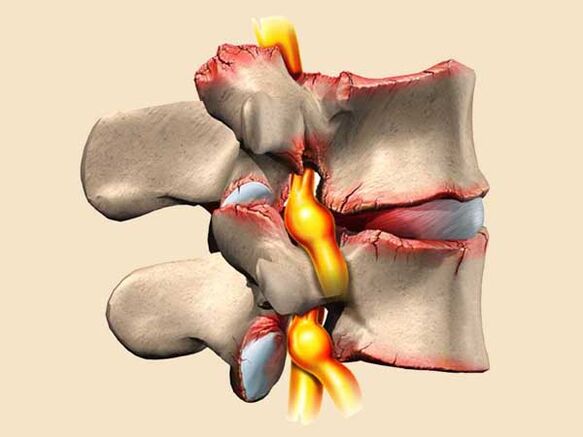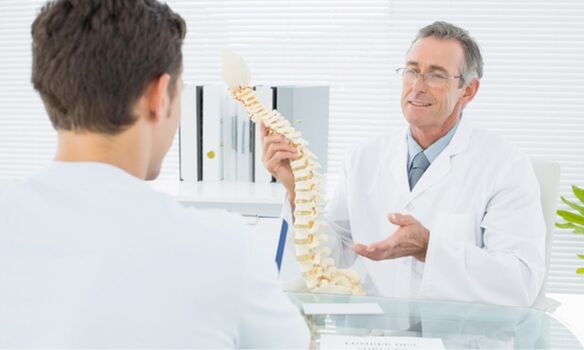Osteochondrosis of the thoracic spine (TOP) is a dystrophic (destructive) degenerative change in the function and condition of the intervertebral fibrocartilage formations (intervertebral discs).
This disease, despite its high prevalence, is characterized by the difficulty of recognizing it at the initial stage of development, since its symptoms resemble those of gastrointestinal diseases (peptic ulcer, gastritis, gastrologic syndrome in colitis), angina pectoris, and sometimes myocardial infarction.

Osteochondrosis of the thoracic spine is very difficult to diagnose.
Less often, this disease is "disguised" as renal colic with cholecystitis or appendicitis. That is why you need to know the symptoms of osteochondrosis of the thoracic spine in order to correctly diagnose them and start treatment in a timely manner.
How does osteochondrosis GOP develop?
In the human spine (more precisely, in the column) there are 33 to 35 vertebrae connected by elastic discs composed of connective tissue and the nucleus.
So, with the development of the disease (this is about 12 vertebrae), first of all, the connective tissue around the intervertebral discs is deformed, as a result of which their elasticity decreases.
As a result, intervertebral discs lose their inherent strength and elasticity, leading to one of two scenarios over time:
- ruptures of the intervertebral discs, as a result of which intervertebral hernias appear;
- Spinal deformity + damage to individual vertebrae in the spine.

The second scenario is a consequence of the growth of bone outgrowths along the edges of the spine, their deformation and thinning.
In osteochondrosis of the thoracic spine, there are 4 degrees of deformation:
- Reduced elasticity and height of the intervertebral discs, protrusions may appear.
- Osteochondrosis of the 2nd degree of the thoracic spine is characterized by a further decrease in the elasticity and height of the intervertebral discs, instability of the GOP. As a result, the appearance of neurological symptoms or hernias.
- Formation of an intervertebral hernia.
- Discs lose shock absorbing properties. The approaching vertebrae almost completely lose their mobility.
causes of the disease
Aging is considered the main reason for the development of this disease, since, according to statistics, the symptoms of osteochondrosis of the chest region usually appear in people over 35 years old. Which contributes to the deterioration of metabolism, the "piling up" of injuries and the general wear and tear of the spine.
In other words, the older the patient, the higher the probability of detecting signs of thoracic osteochondrosis.
But, in fairness, it should be noted that recently more and more patients aged 19-30 are turning to neurologists with chest pain, which is increasingly being diagnosed as symptoms of thoracic osteochondrosis. Doctors explain such dynamics with poor physical fitness, poor nutrition, curvature of the spine and flat feet. These violations are typical of people living in an urban environment with "office" work.

Common causes of the development of thoracic osteochondrosis:
- spinal injury;
- genetic predisposition;
- Immobility;
- obesity and smoking (metabolic disorders);
- prolonged stress on the spine from incorrect postures;
- excessive loads;
- wrong, poor diet (lack of fluids and trace elements);
- overload of the spine due to various diseases or wearing uncomfortable shoes;
- stressful situations, nervous tension;
- violation of posture;
- Diseases that lead to metabolic disorders.
Symptoms and signs of chondrosis of the breast
As already mentioned, the sensations in thoracic osteochondrosis (symptoms) very often resemble other diseases, since they are less pronounced compared to other types of this disease.
Therefore, it is very important not to self-diagnose persistent, intermittent, or "unrelated" thoracic spine pain, but to consult a qualified physician.

Symptoms of osteochondrosis GOP:
- pain between the shoulder blades when bending or raising your arms;
- pain between the ribs when walking;
- with thoracic osteochondrosis, it is difficult to breathe with increased pain with deep inhalation or exhalation;
- Feels like a tire is squeezing your back and chest.
Chest pain in thoracic osteochondrosis occurs:
- after or during a long stay in one position;
- slopes;
- physical activity;
- turns;
- at night.
Additional (special) symptoms of thoracic osteochondrosis, which can be masked as other diseases, especially in women:
- ringing and rushing in the ears;
- regular headaches;
- hoarseness and hoarseness;
- drop in blood pressure;
- numbness of the limbs;
- burning sensation in the chest, similar to heart pain in a heart attack, angina pectoris or pathology of the mammary glands;
- in old age frequent loss of consciousness;
- attacks of shortness of breath;
- constant tension in the neck muscles;
- frequent hiccups.

It is worth noting that in women the symptoms of osteochondrosis of the GOP are more pronounced, since their vertebrae are smaller and the connective tissue is thinner.
It is important to clarify that, contrary to popular belief, with osteochondrosis of the thoracic spine, body temperature does not rise precisely because of this disease. However, it can increase due to inflammatory processes caused by osteochondrosis of the GOP.
characteristics of pain
With osteochondrosis, pain in the sternum is manifested as:
- Dorsalgia - mild, excruciating, fatiguing pain in the area of damaged intervertebral discs, gradually increasing and lasting up to 2-3 weeks;
- Dorsago is a strong, sharp, acute pain during an attack of thoracic osteochondrosis, also known as "chest back pain. "
diagnosis
Since osteochondrosis of the thoracic spine occurs less frequently than other diseases and its symptoms are typical of other diseases, it sometimes takes a long time to make the correct diagnosis (trial and error). And only after the most obvious options have been ruled out, doctors turn to the symptoms of osteochondrosis.
Therefore, when characteristic pain sensations appear, experts recommend contacting medical institutions specializing in problems with the musculoskeletal system.

The diagnostic process itself takes place in 2 stages:
- Determination of the primary diagnosis: Examination and questioning of the patient. Usually this is done by a neurologist. Using a special technique, he examines the spine in various postures, states of rest and movement, paying attention to the body structure, posture and the line of sharp processes. After detecting signs of osteochondrosis of the GOP, a more detailed examination (finger) of the damaged area is performed to determine the location and degree of the disease.
- In addition, after the initial diagnosis, the patient is sent for a basic and more thorough examination of the thoracic spine: X-ray, CT and MRI.
How is osteochondrosis GOP treated?
Treatment is almost always carried out by conservative methods aimed at preventing the development of the disease, eliminating pain and restoring the functions of the spine.
If that doesn't help, surgery is required.
Conservative treatment includes:
- Physical therapy;
- special diet;
- therapeutic blockade;
- Massage;
- drug therapy;
- manual technique;
- spinal traction;
- reflexology;
- Physiotherapeutic exercises (LFK).
prevention
Methods to prevent the occurrence of osteochondrosis GOP are very simple:
- prevent hypothermia of the spine;
- avoid excessive loads;
- frequent change of posture in "office", sedentary work and breaks every hour for 5-10 minutes;
- morning gymnastics.





































